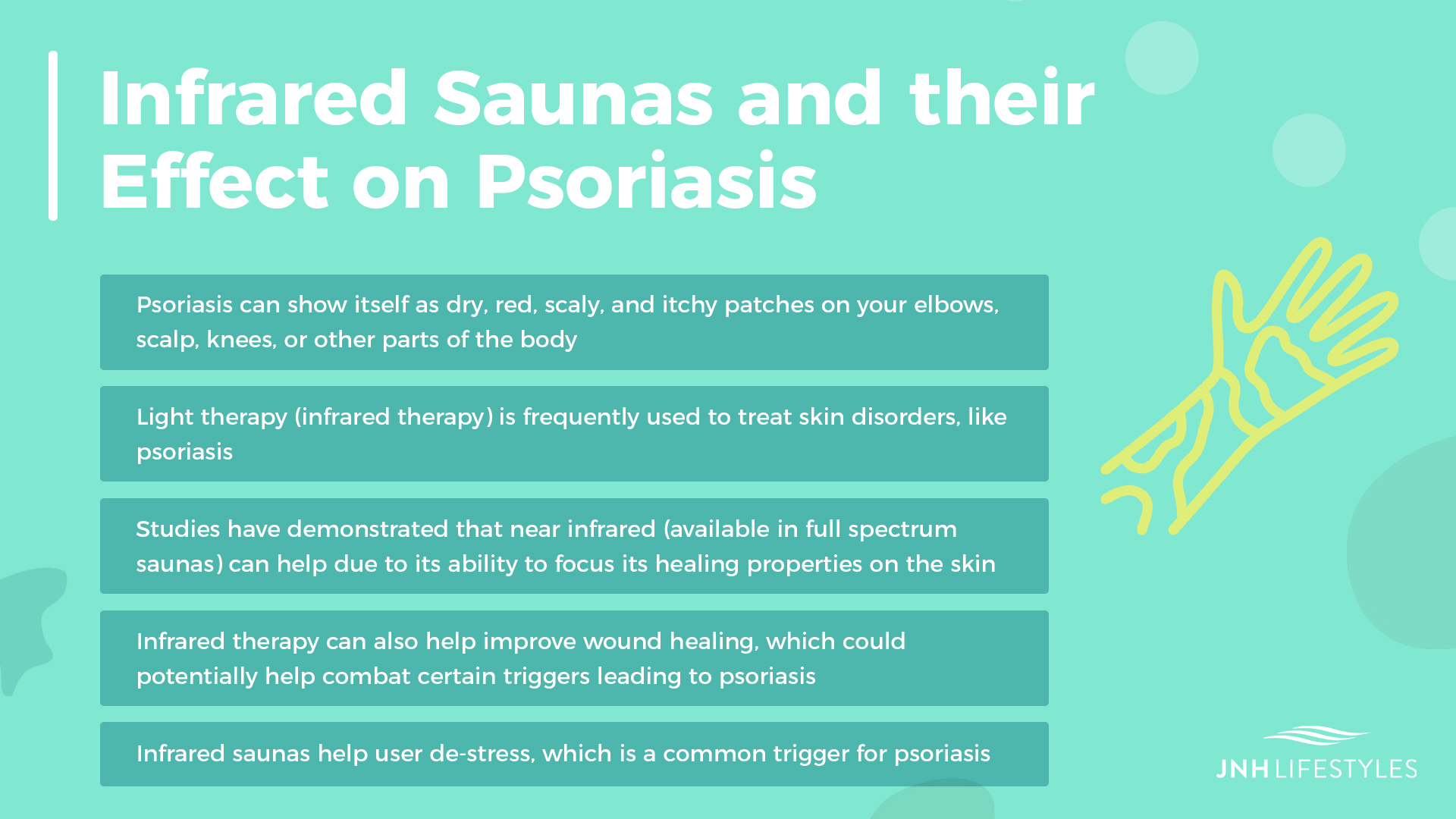Infrared Saunas: Calming The Side-Effects of Psoriasis
About 2-3% of the global population has psoriasis, which is an autoimmune skin disease that often develops between the ages of 15 and 25 [1]. This disease appears as red and itchy patches on the skin, such as on the elbows, knees or scalp. It also tends to frequently consist of cycles, which means a person with this chronic condition may experience remission for a period of time, followed by flare-ups. However, there are several ways you can calm the effects caused by psoriasis. But first, let's take a closer look at why psoriasis happens in the first place before we dive into treatment.
Psoriasis Causes
As previously stated, psoriasis can show itself as dry, red, scaly and itchy patches on your elbows, scalp, knees, or other parts of the body. It can range from only a couple of spots to several that may cover bigger areas. Psoriasis is an autoimmune condition where the skin regenerates quickly, causing a build-up of skin cells [2]. This build-up rises to the surface, creating a scaly appearance and various discomforts.
Experts aren’t entirely sure why psoriasis happens. However, they have noticed a trend in potential triggers of the condition, including infection, climate changes, stress, smoking, medications, excessive alcohol consumption and skin injuries like a bug bite or a cut. Generally, it’s your immune system that attacks your cells, which causes your body to produce more skin in the affected area, leading to a build-up of skin cells. There also may be a genetic factor involved, but more research is necessary to determine precisely why this happens.
There are also various types of psoriasis, including:
- Plaque psoriasis - This is the most common type; affecting the skin and causing red and scaly patches.
- Nail psoriasis - Psoriasis can occur in the fingernails, causing abnormal growth or discoloration.
- Guttate psoriasis - This type of psoriasis is most common in children or adolescents, and creates scaly lesions on the trunk or extremities.
- Pustular psoriasis - This type is a more rare form of psoriasis, and is categorized by pus-filled lesions in large patches.
- Inverse psoriasis - Sometimes caused by fungal infections, this type of psoriasis impacts skin folds and may become worse due to sweat or friction.
- Erythrodermic psoriasis - This is the rarest form of psoriasis, where a large, red and peeling rash occurs across the entire body.
- Psoriatic arthritis - Like most forms of arthritis, this type of psoriasis results in painful joints and sometimes causes nail changes as well.
Psoriasis Treatment & How Infrared Saunas Can Help
Luckily, there are various ways to decrease the symptoms associated with psoriasis. In some cases, your doctor will prescribe certain medications for brief periods to help address severe symptoms, such as steroids, retinoid pills, methotrexate, and more. While moderate to severe cases typically involve the use of topical creams, like corticosteroids, vitamin D analogues, calcineurin inhibitors and retinoids, infrared therapy can also decrease psoriasis symptoms.
Light therapy (infrared therapy) is frequently used to treat skin disorders, like psoriasis. In particular, studies have demonstrated near infrared light to help due to its ability to penetrate the skin and its use in other therapeutic realms [3]. It’s also suggested that infrared therapy may help improve wound healing, which could potentially help combat certain triggers leading to psoriasis or flare-ups, and help decrease the immune response [4].
Infrared saunas are also commonly used to help individuals de-stress and relax and help reduce inflammation throughout the body [4]. Since stress is a common trigger of this disease, regular infrared sauna sessions can help eliminate this trigger and reduce flare-up incidences. Lastly, reducing inflammation can help decrease associated symptoms and prevent discomfort.
While infrared sauna use is an excellent addition to your regular health and wellness routine, it should not replace any treatment recommended by your doctor. Check with your family physician before using an infrared sauna and make sure it’s right for you. Once your doctor gives the green light, you can begin using infrared saunas to help not only combat your psoriasis but also improve your overall health and well-being.

Resources:
[1] National Psoriasis Foundation. (2020). “Statistics.” psoriasis.org, 2020, https://www.psoriasis.org/content/statistics.
[2] Mayo Clinic. (2020). “Psoriasis.” mayolinic.org, 2 May 2020, https://www.mayoclinic.org/diseases-conditions/psoriasis/symptoms-causes/syc-20355840.
[3] Zhang P., & Wu M.X. (2018). “A clinical review of phototherapy for psoriasis.” ncbi.nlm.nih.gov, Lasers in medical science, 2018, https://www.ncbi.nlm.nih.gov/pmc/articles/PMC5756569/.
[4] Hussain J., & Cohen M. (2018). “Clinical Effects of Regular Dry Sauna Bathing: A Systematic Review.” ncbi.nlm.nih.gov, Evidence-based complementary and alternative medicine, 24 April 2018, https://www.ncbi.nlm.nih.gov/pmc/articles/PMC5941775/.

